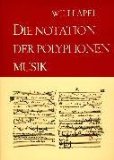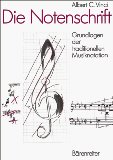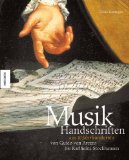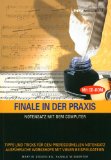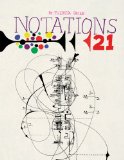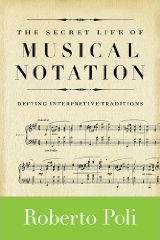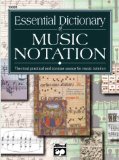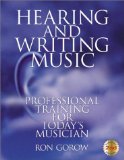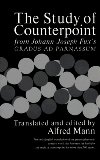|
Buch, Gebundene Ausgabe: 527 Seiten
Verlag: Breitkopf & Härtel; Auflage: 5. A. (1982)
Sprache: deutsch
Schon frühzeitig war die mündliche
Überlieferung einstimmiger Gesänge auf Gedächtnisstützen angewiesen, die neben der
Metrik des Textes den genauen Intervallverlauf durch Neumen kenntlich machten. Aber erst
die kunstvolle Mehrstimmigkeit verlangte nach einem notengetreuen Schriftbild, weil es nun
beim Zusammenspiel mehrerer Stimmen gewisse Regeln zu beachten galt. Veranschaulicht
bereits die Mensuralnotation der ars nova mit ihren häufigen Ligaturen und komplizierten
Zeitangaben einen theoretischen Höhepunkt, so vereinfachte das praktische Musizieren die
rhythmisch differenzierte Stimmordnung zur einheitlichen 'partitura' wie auch die
Tabulaturen einzelner Instrumente, die ähnlich dem späteren Generalbaß anstatt Noten
bloß Ziffern oder Buchstaben benutzten.
Die genaue Kenntnis dieser alten Notationen bildet jedoch die Voraussetzung für das
Verständnis jener polyphonen Werke, da die gesamte Musik vor 1600 meist in einer von der
heutigen Notenschrift abweichenden Form notiert worden ist. |
Encore
Notation
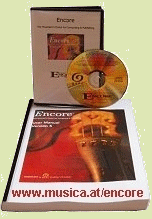
Neu GVox Encore 5!
Notendruckprogramm mit sehr umfangreichen
Funktionen: Eingabe von Noten und Pausen über Mausklick, Step-by-Step Eingabe über Maus
und MIDI-Keyboard oder Realtime-Eingabe über MIDI-Keyboard.
Updates Encore 5 Windows und Mac! Passport Music Software

MusicTime
Deluxe
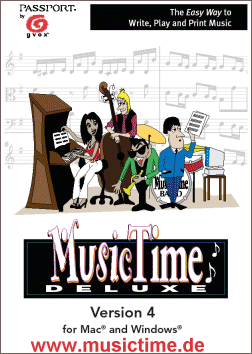
Neu MusicTime Deluxe 4!
Notenschreibprogramm mit sehr
umfangreichen Funktionen: Noten-Assistent zum schnellen Erstellen neuer Partituren,
automatischer Einzelstimmen-Auszug, Noteneingabe mit einem MIDI-Keyboard...
Updates MusicTime 4 für Windows und Mac! Passport Music Software
MusicTime Deluxe 4 deutsches Handbuch - Anleitung online

MagicScore
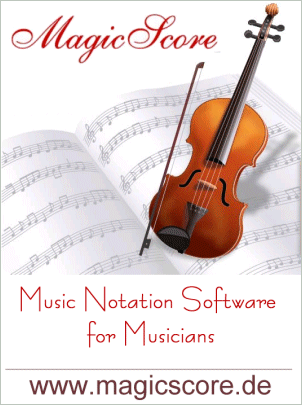
Magic Score Maestro
MagicScore: Die günstige Alternative zu
anderen Notensatzprogrammen gibt es jetzt auch auf Deutsch. Jetzt Testversion
herunterladen...

Musik Notation

Sibelius
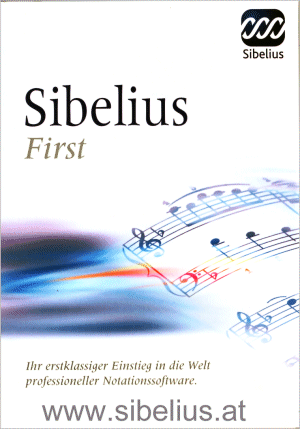
Sibelius & Sibelius First
Noten erstellen, drucken und im Web
publizieren. Sibelius First ist mehr als nur eine Einstiegsversion von Sibelius.
Erstklassige Ausstattung zu einem äußerst attraktiven Preis.

Finale
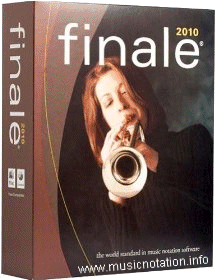
Finale MakeMusic!
Powerful music-notation software with
extensive note-entry options • Compose, arrange, notate, and print engraver-quality
sheet music.

Songwriter
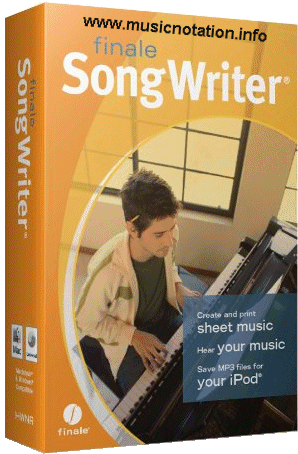
Finale Songwriter
Music-making software for songwriters,
band directors, students, and other musicians. Play MIDI keyboard and see music appear
instantly; import and export MIDI and MusicXML files.

Guitar Pro
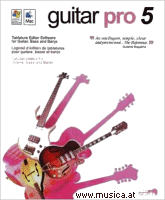
Tablature Editor
Guitar Pro ist ein Mehrspur Tabulatur
Editor für Gitarre, Banjo und Bass - auch alle anderen vier-, fünf-, sechs- und
siebensaitigen Instrumente mit Bünden werden unterstützt, und deren Stimmung ist völlig
frei konfigurierbar.

Encore Notation

Neu GVox Encore 5!
Notendruckprogramm mit sehr umfangreichen
Funktionen: Eingabe von Noten und Pausen über Mausklick, Step-by-Step Eingabe über Maus
und MIDI-Keyboard oder Realtime-Eingabe über MIDI-Keyboard.
Updates Encore Windows und Encore Mac! |
|
Buch, Gebundene Ausgabe: 122 Seiten
Verlag: Bärenreiter Verlag; Auflage: 2., Aufl. (1991)
Sprache: Deutsch
Grundlagen der traditionellen
Musiknotation
Wie schreibe ich Musiknoten richtig? Wie behandle ich Hilflinien und Behalsung bei
komplizierten Akkorden, wie Artikulationsbögen und Balken? Dieses Buch gibt Antwort auf
Fragen, die sich jeder stellen muss, der mit der Niederschrift von Musik zu tun hat. |
|
|
|
Buch, Gebundene Ausgabe: 215 Seiten
Verlag: Knesebeck (2005)
Sprache: Deutsch
Dieser Band zeigt die 100 schönsten
Autografen aus 10 Jahrhunderten klassischer Musik. Ob Blätter von Bach, Mozart, Beethoven
oder Brahms - alle illustrieren sie die bemerkenswerte Vielfalt des musikalischen
Schaffens, das man gar nicht zu kennen braucht, um sich vom visuellen Spiel der Noten
verzaubern zu lassen.
Über den Autor:
Gilles Cantagrel ist Musikwissenschaftler und war Direktor von Radio France Musiques, wo
er heute noch mehrere Sendungen leitet. Er ist ein international anerkannter Experte für
das Werk Johann Sebastian Bachs, zu dem er bereits mehrere Bücher veröffentlicht hat. |
|
Taschenbuch: 320 Seiten
Verlag: PPV MEDIEN; Auflage: 1 (1. August 2006)
Sprache: Deutsch
Durchblick beim Notensatz: 14 Workshops
zeigen wie Noten perfekt auf Papier gebracht werden. Dabei werden die Kenntnisse an Hand
von praktischen Beispielen vermittelt. Der Anwender kann alle Erläuterungen an Hand der
auf der CD mitgelieferten Beispiele sofort nachvollziehen und in die Praxis umsetzen.
Egal ob Leadsheet, Klavierstück, Solo Notation, Gitarre und Tabulatur, Bläsernoten,
Perkussion oder Drums mit diesem Buch geht dem Anwender ohne Zeitverlust jeder Notensatz
leicht von der Hand.
Über den Autor
Martin Gieseking ist wissenschaftlicher Mitarbeiter an der Universität Osnabrück und
Mitglied der Forschungsstelle Musik- und Medientechnologie. Er promovierte in
Musikinformatik über die automatische Generierung von Notengrafiken. Harald Wingerter
studierte Musikwissenschaft und Jazz-Arrangement und -Komposition. Er arbeitet seit über
10 Jahren mit 'Finale' und setzt Noten für viele renommierte Musikverlage. |
|
Buch, Gebundene Ausgabe: 336 Seiten
Verlag: Alpha; 2nd edition (September 6, 2005)
Sprache: Deutsch
Rezension
Dieses Buch entpuppt sich als wahre Schatztruhe! Es bietet eine unglaubliche Fülle an
Spielen, Arbeitsblättern und Kopiervorlagen, die sehr kreativ und abwechslungsreich sind.
Auch so schwierige Themen wie Rhythmus und Notenlehre erscheinen hier mühelos und werden
von den Kindern spielerisch erlernt. Kein Spiel oder Arbeitsblatt gleicht dem anderen.
Alle Vorlagen müssen nicht verändert werden - sie können direkt übernommen werden. Die
Materialien eignen sich auch für etwas ältere Kinder, da die Schwierigkeitsanforderungen
unterschiedlich gehalten sind. Ein tolles Buch, welches ich absolut empfehlen kann!
Kurzbeschreibung:
Die Arbeitsblätter sollen dazu beitragen, den Umgang mit Notation abwechslungsreich zu
gestalten. In vielen Fällen gelingt es nämlich nicht, SchülerInnen ausreichend für die
Beschäftigung mit traditioneller Notation zu motivieren. Es wurden deshalb Formen des
Übens gewählt, die dazu anregen, auf spielerische Weise erworbene Kenntnisse zu
vertiefen. Hierfür wurden Würfelspiele, Rechenspiele, Malspiele, Rätsel, Geschichten
und Schreibübungen in Verbindung mit musikalischen Aufgaben entwickelt. Die vorgegebenen
Modelle können als Anregungen für weitere Aufgaben dienen.
Über den Autor:
Prof.
Dr. Rudolf-Dieter Kraemer, Lehrstuhlinhaber für Musikpädagogik an der Universität
Augsburg; Herausgeber der Reihe FORUM MUSIKPÄDAGOGIK im Wißner-Verlag Augsburg; zur Zeit
Vorsitzender des Arbeitskreises Musikpädagogische Forschung (AMPF). Prof. Dr. Wolfgang
Rüdiger, Leiter des Studiengangs Musikerziehung an der Hochschule für Künste Bremen, ab
Oktober an der Robert Schumann Hochschule Düsseldorf; ständiger Mitarbeiter der
Zeitschrift Üben & Musizieren; Fagottist, Mitbegründer und künstlerischer Leiter
des Ensemble Aventure. |
|
Paperback: 320 pages
Publisher: Mark Batty Publisher (April 30, 2009)
Language: English
Drawing inspiration from John Cage's Notations , Notations 21 features illustrated musical
scores from more than 100 international composers, all of whom are making amazing
breakthroughs in the art of notation. These spectacularly beautiful and fascinatingly
creative visual pieces not only make for exciting music, but inspiring visual art as well.
The scores are accompanied by written contributions from the artists that explore every
facet of their creative processes, from inspiration to execution. Contributors include the
likes of Karlheinz Stockhausen, Earle Brown, Halim El-Dabh, Joan La Barbara, and Yuji Takahashi, as well as emerging composers whose
compositions are also visually astounding and important. In the spirit of honoring the
40th anniversary of Cage's seminal book, while furthering it in a 21st century context, a
portion of the sales will be donated to the Foundation for Contemporary Performing Arts. |
|
Paperback: 160 pages
Publisher: BERKLEE COLLEGE -LICENSED (April 7, 2007)
Language: English
Whether you notate music by hand or
use computer software, this practical reference will show you today's best practices
rendering the details of your scores and parts.
Improve your music's legibility and express your ideas clearly to get the best possible
representation of your music.
You will learn to:
· create scores that are easy to conduct and parts that are easy to perform;
· understand the unique practices and standards for handwritten vs. computer-generated
scores, such as those by Encore
and Sibelius;
· lay out scores with proper instrument order, measures per page, and common alignment
practices;
· understand the publication standards for orchestral, big-band, vocal, and
rhythm-section-based scores;
· use appropriate practices for different styles, such as pop, commercial, classical, and
jazz;
· and more...
Music Notation - Preparing Scores and Parts is used as a notation textbook by Berklee
College of Music's Contemporary Writing and Production Department. It presents the
definitive word in score and part preparation, based on contemporary publishing-industry
practice. |
|
Paperback: 280 pages
Publisher: Amadeus Press (April 15, 2010)
Language: English
The original discoveries presented in The
Secret Life of Musical Notation: Defying Interpretive Traditions have generated one
fundamental conclusion: the long-standing interpretation of several of the markings
commonly encountered in music as early as the 1770s may fail to reveal their original
intentions, being the result of misconstrued readings. These misinterpretations are due
precisely to traditions themselves, which are liable for reifying hearsay as accepted
knowledge. Restoring the original meaning of signs and symbols in the scores can bring us
closer to practices that have not gained access to musicians' vocabulary because of
decades of misinformed playing and fallacious scholarship, giving us greater interpretive
insight. Many contemporary musicians who have read the book believe the concepts expressed
in it will have a strong impact on the way we read music. They claim that applying these
concepts has made them think more thoroughly about the role of musical notation and the
way they approach the printed page. |
|
|
|
Paperback: 290 pages
Publisher: Taxi Music Books; 1ST edition (October 15, 2008
Language: English
Here are 126 Shortcuts that will take
your songs from good to great!
Discover the melody and lyric writing techniques of today's top songwriters and learn how
you can use the very same secrets to give your songs the power and edge that will make
listeners want to hear them over and over again.
You'll learn... 38 proven strategies for creating powerful, unforgettable lyrics, 30
simple ways to make your melody fresh, exciting, and memorable, how to use hit songs as
"ghost songs" to get quick results. Plus, there are 58 more Shortcuts to help
you lay the groundwork, pick the perfect structure, and choose the chords that will give
your songs even more hit potential. And there are more than 100 "Do It Now"
exercises to get you started right away! |
|
Paperback: 208 pages
Publisher: Routledge; Pap/Com edition (May 26, 2004)
Language: English
Everyone dreams of being a successful
songwriter. In every city and town, down the block in every neighborhood, someone is
taking a guitar in hand and dreaming of a career as a songwriter. While many will not
become world famous (or even locally well-known) through their songwriting, there's no
reason why they-and you-can't enjoy writing their own songs. For creative challenges,
life-long learning, and just plain fun, nothing beats writing (and singing and playing)
your own songs.
Assuming no musical knowledge, Songwriting Success breaks down the craft of melody and
lyric writing into easily digested lessons that anyone can follow. This book shows the
beginning songwriter how to integrate the craft's many skills into a seamless artistic and
commercial whole.
Lydon also has recorded a special CD taking the budding songwriter who can't read music
(or prefers to learn by listening) step-by-step through the writing of a song-from initial
idea through crafting melodic hooks and catchy choruses to creating a final
"demo" version for marketing the song. This invaluable learning aid sets apart
Songwriting Success from the competing titles that don't feature an audio component. Also
includes 25 musical examples. |
|
Paperback: 352 pages
Publisher: Alfred Publishing Co., Inc. (December 1996)
Language: English
This pocket-sized dictionary presents
current and correct notation practices in an easy-to-use format. Generously illustrated
and concise, this book is essential to any musician looking for a handy reference for the
correct notation of music.
A most welcome and beneficial source for every musician, whether using a pencil or a
computer. |
|
Paperback: 176 pages
Publisher: W.W. Norton & Co.; 1st edition (February 17, 1987)
Language: English
This book is essential for all composers
and arrangers. My book covers all essential aspects of traditional music notation.
My experience as a teacher of music theory at the college level has shown that students of
composition are very weak in their knowledge of the rights and wrongs of music notation.
My book serves to correct this fault in a clear and concise manner. Even for those
composers who produce musical scores on a computer program, they must have a clear grasp
of notational principles, since the computer does not know all of the rules. A score that
is correct in every way in terms of notation is extremely important if you expect to
receive performance.
George Heussenstamm |
|
Paperback: 448 pages
Publisher: September Publishing; 2nd edition (September 2002)
Language: English
A self-training manual as well as a
classroom text, this book is a complete step-by-step course to develop the musician's
ability to hear and notate any style of music. Personal training, thoery and exercises
produce techniques which are combined in an integrated craft which may be applied to
composition, orchestration, arranging, improvisation and performance.
In this book you will discover: Transcribing techniques. How to maximize your creativity
and productivity. How to develop your craft by consolidating techniques. How to read music
with your ears. How you can write music without using an instrument. How to write music
spontaneously, as your ear guides your hand. How to communicate accurately through music
notation. Why you don't need "perfect pitch." Tools to develop your music
perception. 140 exercises, many music examples—models for a lifetime of study.
Resources for composing, orchestrating, film scoring. Working in the music business. Where
to find supplies, organizations, information, inspiration. A definitive guide and
reference for composers, orchestrators, arrangers and performers.
About the Author
Ron Gorow has consolidated his 40 years experience in Hollywood as a composer,
orchestrator, arranger, copyist, music engraver, score proofreader, musicologist and
teacher to develop the techniques presented in Hearing and Writing Music. He is a member
of Professional Musicians Local 47, Recording Musicians Association, International
Association of Jazz Educators and American Society of Composers Authors and Publishers. |
|
Paperback: 156 pages
Publisher: Study of Counterpoint: From Johann Joseph Fux's Gradus Ad Parnassum)
Language: English
The most celebrated book on counterpoint
is Fux's great theoretical work Gradus ad Parnassum.
Since its appearance in 1725, it has been used by and has directly influenced the work of
many of the greatest composers. J. S. Bach held it in high esteem, Leopold Mozart trained
his famous son from its pages, Haydn worked out every lesson with meticulous care, and
Beethoven condensed it into an abstract for ready reference. |
